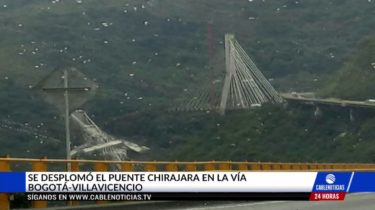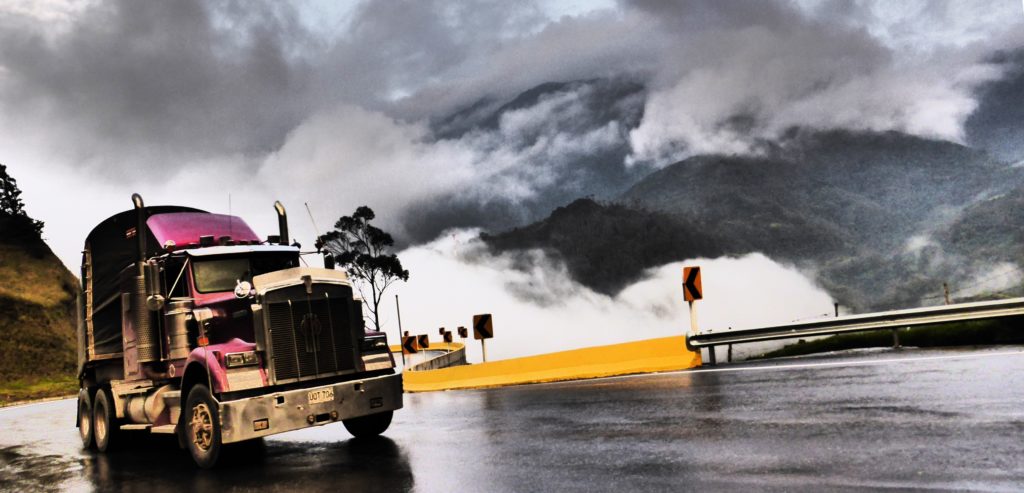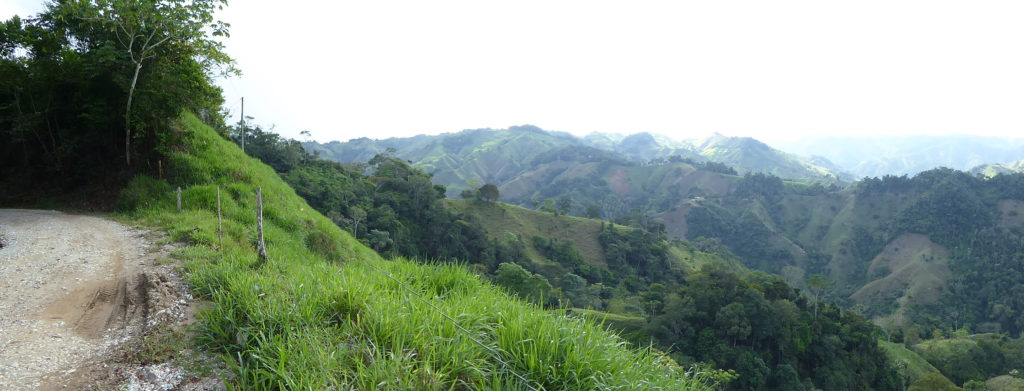If it can go wrong…

by Steve Hide
A version of this article first
appeared in The City Paper in 2018
Driving the switchbacks of Route 25, the main road from the coast to Medellin, I push the accelerator pedal to the floor and swing out past a smoking truck, scanning the road ahead for obstacles or on-comings, catching glimpses of the Rio Cauca rushing through its magnificent gorge far below, while my kids are yelling in my ear ‘Come on, come on, we can pass it!’.
I make the hair-split decision to pull back and tuck in when another big Mack comes steaming down the hill all air horn and hot asbestos. Our little car shudders in its slipstream.

Driving Colombia’s main roads is a white-knuckle ride worthy of any theme park and, travelling as I do several times a year from Bogota to the coast (a two-day drive whichever way you go) gives us plenty of thrills and plenty of time to complain about the country’s infrastructure problems.
My family are well used to my rants by now. First up is usually drainage, along the lines of: ‘OK, so they have built a new road but why the hell don’t they put in proper gullies and drainage channels.’ My children then have to suffer a sermon on the fact that the asphalt road surface looks hard but is ‘actually a liquid’ and can deform like plasticine under those 55-tonne trucks, more-so if the ground is soggy with water filtration.
But, of course, that effect is worse if the asphalt layer is gossamer-thin in the first place, which seems to be the case in the newish four-lane Ruta de Sol that skirts the Magdalena River, and focus of multi-million-dollar corruption scandals. ‘They skimmed the contracts – and the tarmac!’ I yell, as we deviate around a newly-formed pothole on this flagship highway.
Then, on a mountain stretch, comes an ominous road-sign stating, ‘Geological Fault: Zone under Observation’. This message always sends me into a rage as the road ahead deteriorates into a series of steps and then one lane disappears altogether over a cliff. The problem is the same hole, same steps, same sign have been there for five years.
‘How many more years are they going to just watch it!’ I shout, to no-one in particular, given that my passengers have heard the same rant at precisely the same spot for five years and are now oblivious to my exhortations.
The toll booth blues

But hell hath no fury like my wrath at turning up at the single-cashier toll booth between Monteria and Caucasia. The deal on this stretch of road is that, yes, the engineers seem to have done a good of putting on dual carriageway and passing lanes, and even a smidgeon of drainage, and we cruise smoothly past Cordoba’s lush haciendas with their dopey brahman cattle. But then we inexplicably stop.
Then it becomes clear that the 500-metre-long queue of traffic is waiting to pass through the single toll booth. Yes, all the time gained on this super new road is instantly squandered by queuing for 20 minutes for the privilege of handing over $12,000 pesos – one of the highest road tolls in Latin America – because some mulish planner forgot to blueprint a multi-booth toll station.
‘This is nuts!’ I yell at a vendor as he walks down the line of cars to sell his rosquitos and gaseosas.
My impatience is tempered by news of a bridge collapse on another road far away, between Bogota and Villavicencio. One span of the unfinished Chirajara suspension bridge has collapsed carrying construction workers into the gorge below with a dozen deaths and more injured.

The 450-metre construction was visited by President Santos just two months previously and lauded as a ‘100 per cent Colombian-engineered infrastructure marvel’, similar to those found ‘in Switzerland, in Germany, in the States United’, and a ‘source of pride to all Colombians.’ And then the fall.
The event is a tragic start to 2018 – along with a landslide in Nariño that buries a bus with multiple fatalities – and a reminder of the immense challenge of taming the wild Andes, the planet’s longest, newest and most restless mountain range. As President Santos correctly pointed out during his site visit, the Andean geography is ‘much more complicated because these are mountains in formation and that requires more care, requires a more sophisticated engineering’. So, it was never going to be easy. In fact, a landslide swallowed 200 souls in the same spot in 1974.
Where the ‘sidewalks fall down’
But behind that reality is the lingering suspicion of human ineptitude. ‘In Colombia, even the sidewalks fall down’ is one meme doing the rounds on social media and upsetting an engineering friend. ‘We make the best plans, the problem is the end product,’ she says. ‘Constructors skimp on materials and it all fails’.
Looking back over the years it seems that Colombia has more than its fair share of infrastructure collapses. According to one engineering reports at least 63 bridges have fallen down in the last 30 years due to structural failure or ‘scour effects’, a technical term for being washed away.
Buildings also collapse on an all-too regular basis with an all-too familiar pattern: multiple deaths, the revelation that building codes/planning laws/plain common sense was not observed, bribes paid to avoid inspection, a background of cost-cutting prompted by a carrousel of sub-contracting (so politicos and elite can line their pockets with taxpayers’ money) then the promise of an inquiry and legal action against the guilty parties. Then nothing. Until the next one.
The surprise with Chirajara was that it was supposed to be part of a new generation – the so-called Fourth Generation – of massive public-private road building enterprise umbrellaed by a new government agency, the Agencia Naiconal de Infraestructura with a brief to clean up the business.
Of course, we do not yet what, if any, human factors apply to Chirajara tragedy, or if its collapse was force majeure. The event is still on our minds as we wind our way through Antioquia, at one point leaving behind the hectic main road and taking the muddy tracks over the mountains from Barbosa to Concepcion, Alejandria, San Rafael and San Carlos.
This is Colombian another style of Colombian driving: winding dirt roads with plenty of natural hazards but no traffic, just the occasional rural chiva bus. And no tolls. It is hard work at the wheel, but I much prefer to spar with the road than monster trucks. We stop to explore crystalline rivers and waterfalls and look for torrent ducks, and overnight in remote rural towns where after dark drunken vaqueros storm the cobbled streets on their high-stepping mounts.
Then we reach San Carlos, a vibrant town and plaza, good but cheap hotels, and excursions to a mysterious jungle-clad mountain topped by limestone massif. And another collapsed bridge. Yes, our plan to reconnect to the main road to Bogota has been thwarted by failed infrastructure. We stand on the bank of the Rio San Carlos looking down at the jagged concrete stanchions, all that remains of the solid bridge that until October last year spanned this lively river.
‘How can a whole bridge get washed away?’ my daughter asks. I quote Murphy’s law: if it can go wrong, it will go wrong. And, in the case of the San Carlos Bridge, and the Chirajara Suspension Bridge, it did go wrong.
‘How do we get to Bogota?’ I ask a man with a dog. ‘Downstream there is a ford across the river,’ he says, looking or small 4×4 car up and down. ‘With luck you might make it.’
A bridge too far
We find recently-bulldozed muddy access road down to the riverbank, where I sit and contemplate the 60-metre crossing over the surging river. As we watch a mega-wheeled Landcruiser charges across the flow, over-revving and nearly digging its large wheels into the stony riverbed, sending rocks and water spraying in all directions. Water is over the sills now, and for a moment it seems it might be stuck. But it breaks free and scurries up the opposite bank.
‘Let’s do it, dad,’ says my son. Er, no. I explain that, yes, we would probably cross the river OK, but the water would submerge the axles and turn the gear oil therein to mayonnaise. That would mean a lot of mechanical work later. Deep river crossings take some preparation.
So, we backtrack and find an even lonelier – but relatively passable – backroad to Puerto Nare and the Magdalena River. The route follows the Samana river gorge, which it crosses at the (gloriously intact) Puerto Garza road bridge, where we are treated to the sight of a veil of water that cascades off the sheer gorge wall into the river below.

The road is bad again now with plenty of wash-outs and landslides. Here the steep hills have been clear-felled for cattle grazing, and the eroded and scarred hillsides show a clear connection between the human need to eat dead cows, bad farming and collapsed infrastructure. It is not just Man versus Nature, it is also Man versus Man.
As we squeeze by another landslide, I invoke Murphy’s Law again. ‘Who exactly was Murphy?’ asks my daughter from the back seat. ‘Murphy was an optimist,’ I reply. She thinks for a second. ‘Could he have come from here?’.
I think for second. Why, yes. If Gabo was an Irishman, surely Murphy could be Colombian.
